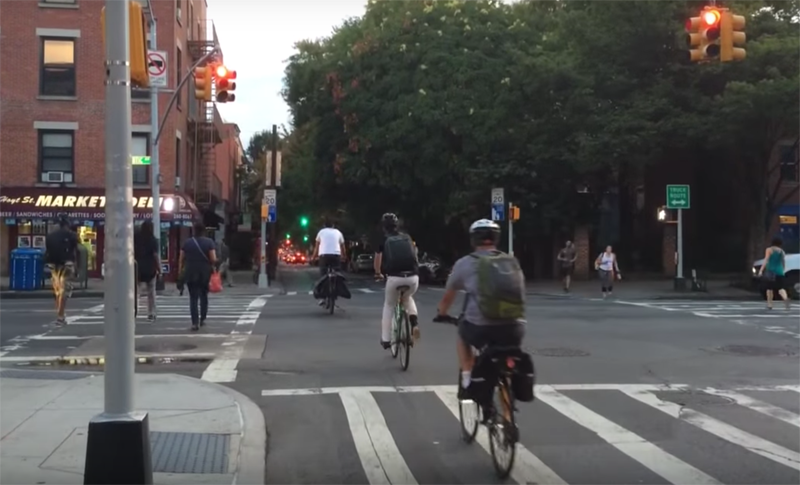Letting People on Bicycles Use LPIs: A New Way Forward on Cycling Safety

One of the most effective tools in New York’s street safety toolkit is also the simplest: the leading pedestrian interval, or LPI. With these signals, people on foot have a range of 7 to 11 seconds to cross before drivers may proceed through the intersection or make turns through crosswalks. With high safety benefits and low installation costs, DOT installed a record 832 LPIs in 2017 for a total of 2,547 LPIs throughout the city, seven times the number prior to the beginning of the Vision Zero program.
Now, the safety benefits of many of these LPIs will be extended to another vulnerable class of street users: people on bicycles.
Today, we join officials from the New York City Department of Transportation and cycling and street safety advocates to announce a pilot program that will allow cyclists to follow pedestrian head-start signals at 50 designated intersections. This critical step was born out months of constructive discussion with NYPD, DOT, and Council Member Menchaca — and consistent testimony from advocates and everyday riders.
As part of the initiative, which will run until October of this year, DOT will install temporary signage at intersections that already have leading pedestrian lntervals indicating that people on bicycles will be able to use these signals to proceed ahead of motorists. It is important to note that cyclists making turns are legally required to yield to pedestrians in crosswalks at all intersections with or without an LPI.
While this program is currently structured to be temporary, we are confident that the data that will emerge at its end will show what many people who ride bicycles in New York already know: Using LPIs to get ahead of drivers at dangerous intersections will keep riders safe, will not burden pedestrians, and will not otherwise cause harm.
After all, this initiative — along with the 2016 legislation introduced by Council Member Menchaca to allow cyclists to follow LPIs — grew not out of some vague notion of improving cycling safety, but from on-the-ground observations of cyclist behavior. Stand at any intersection with an LPI along this city’s busiest cycling routes and one is bound to find dozens of people on bikes using the pedestrian signal to stay a safe distance ahead of drivers. The practice is so common — and has so far resulted in no reported crashes or major conflicts with pedestrians — that many people already assume it is legal.
Whether they know it or not, these New Yorkers are on to something backed up by DOT analysis. The department’s 2016 Don’t Cut Corners study found a 56 percent reduction in serious injury and fatal pedestrian and bicycle crashes at intersections with LPIs. With 89 percent of cyclists killed or seriously injured at intersections, giving people on bikes the opportunity to stay as far away from moving cars as possible is something we must explore as we seek to end the scourge of traffic violence.
Of course, there is more to this pilot program than safety. Allowing cyclists to use LPIs reflects a new and modern understanding of mobility in cities across the world, one that recognizes that bicycles and automobiles are two very different things. Washington, DC, for example, has allowed cyclists to use LPIs legally since 2013. Famously bike-friendly cities such as Amsterdam and Copenhagen use traffic signals that allow cyclists to maintain even, steady speeds for miles without having to stop, and they adjust depending on weather conditions.
As New York seeks to catch up to these cities and solve its mobility challenges, new rules will be needed to account for the fact that a bicycle — which weighs mere dozens of pounds and is powered by human strength — is not the same as a multi-ton, motorized vehicle capable of achieving high speeds at the mere tap of a gas pedal. This pilot program is a good first step towards that goal which will build toward more modernization of our streets in the name of safety.
Carlos Menchaca represents the 38th District of the New York City Council, which includes Sunset Park, Red Hook, Greenwood Heights, and portions of Borough Park, Dyker Heights and Windsor Terrace.
Doug Gordon is a TV writer/producer and a safe streets advocate who blogs at BrooklynSpoke.





